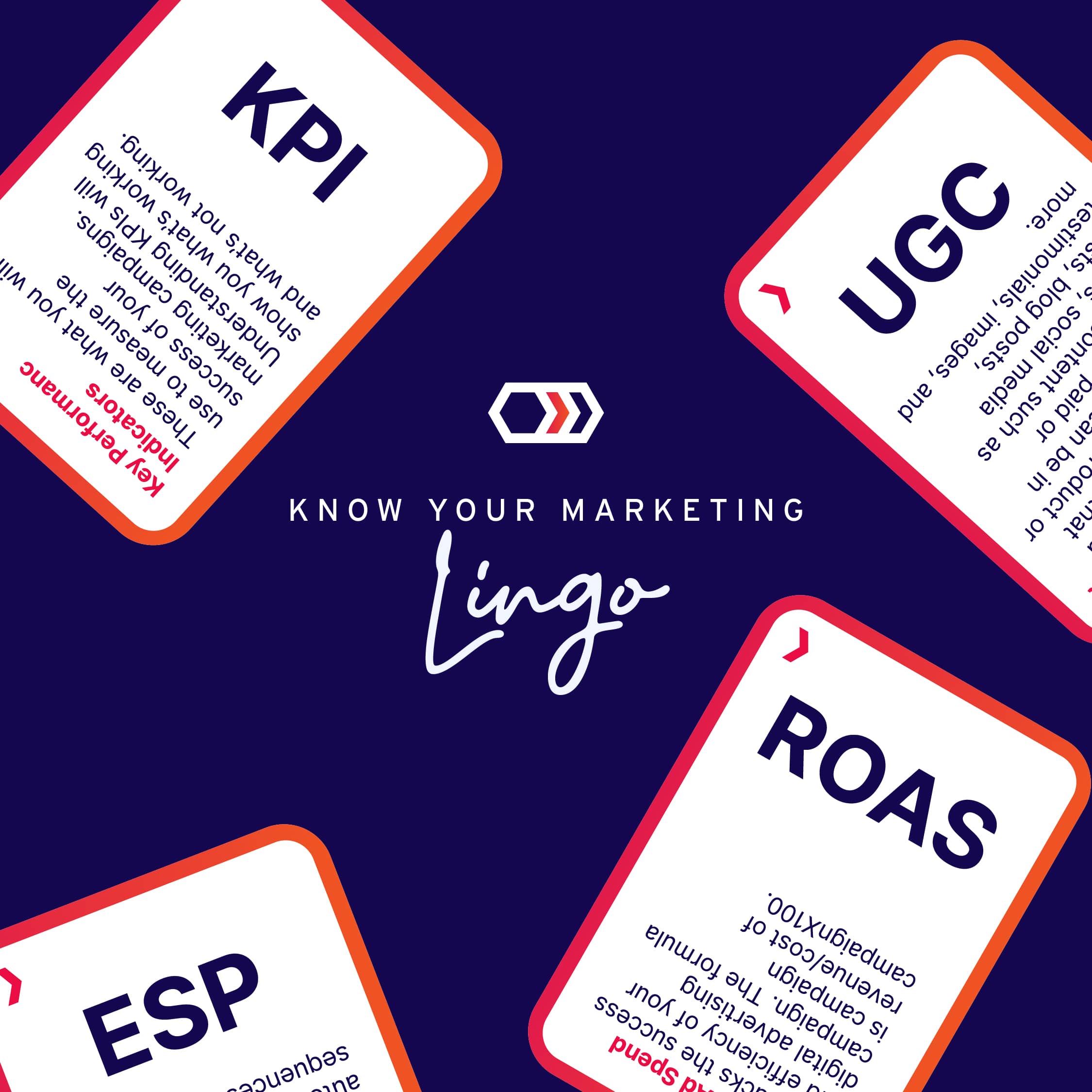We’re marketers, of course it’s going to sound like we’re talking in a secret language. When you are fluent in the language of marketing, you’ll find yourself using more acronyms than words. You can almost make complete sentences with very minimal words. For instance, “Do you know what the ROI is on our PPC campaign? I also need to know the CPC, CTR, and other KPIs. Also, have we jumped on the SERP with our updated SEO?” If you know what all that means, great! If you feel like you’re in the next installment of National Treasure trying to decode a hundred-year-old message, this blog is for you! We’re going to break down some of the most used acronyms in the marketing industry and let you know what they all mean. Bookmark this blog so when you get an email that looks like it is in shorthand, you’ll know what your CMO is asking!
API: Application Program Interface
This is like a digital middleman. It allows one application to talk to another. This is how you’re able to share posts on Facebook. Meta also uses a conversions API in their ads to create a direct and more reliable connection between marketing data from your website, CRM, or app and Meta.
B2B: Business to Business
Think of a software company selling a CRM to a marketing agency. They are selling B2B, or from one business to another.
B2C: Business to Consumer
This is your typical retail store. So anything a business that sells a good or service that anyone can use is a B2C company.
BR: Bounce Rate
This is important for email marketing. Bounce rate is the number of emails that bounce when you try to send an email through a service like Mailchimp. If you have a high bounce rate it could affect your deliverability of future emails.
CMO: Chief Marketing Officer
This person will be responsible for data analysis and strategic planning, and typically oversee the marketing department. They will have a very in-depth knowledge of marketing fundamentals.
CMS: Content Management System
This is a software application that will manage your content. It can help you organize your images, content editing, and publishing. It will also help you publish to multiple platforms all at once i.e. Facebook, Instagram, X, Pinterest, YouTube, and more.
CRM: Customer Relationship Management
This is a software that will help you manage and improve your interactions with your current and potential customers. You can track their journey through your funnel, and keep tabs on demographic info, interactions, purchases, and more.
CTA: Call to Action
This is the most important part of digital ads, emails, and social posts. Your call to action is what you want the person to do. Such as “Shop Now” “Learn More” “Contact Us” etc. Sometimes having a call to action that shows how you can help is beneficial like a “Get your FREE marketing guide here.”
CTR: Click Through Rate
This is relevant in ads and email. Your CTR shows how many people clicked on your ad or email. You want a high click-through rate. So If 1,000 people saw your ad and 600 people clicked on it you would have a 60% CTR.
CTV: Connected TV
This is a TV that is connected to the internet to stream video through services like Sling, Pluto, or any of the “+” channels or apps like Paramount +, Disney + Peacock, and more.
DA: Domain Authority
This is a search engine ranking score. Your DA is evaluated from 1 to 100 and will have an effect on where you show up on the SERP. This score is calculated from a lot of different metrics on your website. The more authority, or higher your score is, the better you will rank.
DNS: Domain Name Server
This is the phonebook of the internet and will translate what we see as a web address like hexcodemarketing.com to a readable IP address for a machine like 123.4.5.67
ESP: Email Service Provider
This is the service you use for your bulk email marketing. It will keep track of your campaigns and can organize which contacts get each campaign, and even automate email sequences. These companies will also provide analytics on your campaigns, and take steps to ensure your emails don’t get flagged as spam.
FAQ: Frequently Asked Questions
This is a common section on most websites that provides answers to the most commonly asked questions about a product, topic, solution, process, or service.
KPI: Key Performance Indicators
These are what you will use to measure the success of your marketing campaigns. Understanding KPIs will show you what’s working and what’s not working. Typical KPIs are click-through, bounce, and conversion rates.
OTT: Over the Top
These are ads connected to CTV, and refer to the delivery of ads through streaming media services that are offered to viewers over the internet. These ads aren’t served on traditional cable, broadcast, or satellite TV services. These ads should be between 15-30 seconds and can also include QR codes. Some platforms even offer website tracking code you can install to track web visitors from the ad.
PPC: Pay Per Click
These are digital ads that will show on websites, emails, apps, and Meta platforms. You pay each time someone clicks on your ad and these will typically drive traffic to your website, app, or landing page.
ROAS: Return on Ad Spend
This tracks the success and efficiency of your digital advertising campaign. The formula is campaign revenue/cost of campaignX100. This is measured based on specific ad campaigns, so if you are running an ad on Google, and you spend $1,000 and your revenue that came in from the campaign is $4,000 your return is 400%.
ROI: Return on Investment
This is different from ROAS because this will track your entire investment. This is figured by taking the net profits divided by the investment cost. If you invest $2,000 in a campaign including ad spend, venue rental, swag purchases etc, and you make $2,800 your ROI is 40%. ($2,800-$2,000=$800) $800/$2,000= 40%
SEM: Search Engine Marketing
This is a form of marketing to increase a website’s visibility typically in the form of advertising (PPC). These results will show as sponsored, and appear above the organic search results.
SEO: Search Engine Optimization
This is a strategy that will help your website rank higher in the organic search results. To have good SEO, you need to make sure the content on your website is high quality, optimized for the correct keywords, and has relevant meta titles and descriptions, and headlines. SEO can take time and demands patience, but once done correctly can increase your long-term visibility and credibility.
SERP: Search Engine Results Page
When someone searches the web they might use Google, Bing, Microsoft Edge, or Firefox. After they search the page that shows is called the search engine results page. It includes a list of websites, images, or products based on the user’s search query. The results that show up will depend on factors like what search engine was used, the user’s locations, and the search intent.
SMART: Specific Achievable, Relevant, Time-Bound
This is a way to make sure you set goals that make sense for your campaigns. You need to have specific outcomes you want to see from your campaigns. An example of a SMART goal would be to increase purchases by 15% in 6 months.
SMM: Social Media Marketing
This is a digital marketing strategy that uses social media platforms. This can include Facebook, Instagram, X, Threads, LinkedIn, Pinterest, YouTube, Snapchat and more. While these platforms can be used to promote sales and products, it should be more about building trust with your target audience. Knowing how to manage your social media is vital to the success of your digital marketing.
UGC: User-Generated Content
This is content created by your customers that highlights your product or service. This can be in the form of paid or unpaid content such as videos, social media posts, blog posts, testimonials, images, and more. This is a great way to build trust and credibility with people who haven’t made a purchase with you yet.
UI: User Interface
What a user sees on your website or app. This encompasses page layout, color scheme and font selection, buttons, and other interactive elements, and the overall appeal of your website or app. For a website, you want to make sure your page is set up to handle all devices like computer screens and mobile devices. Your website should be responsive and display properly per device so the user sees the information correctly.
UX: User Experience
How a user interacts with your website or app. Have you ever purchased something online and had to click add to cart-go to cart-checkout-review order-start checkout-then finally 10 steps later you’ve made the purchase? That’s not the best user experience. You want your website to be easy to navigate and use. If a person has to click 3-4 times to find the information they will most likely leave your site. This also includes your load time and ensuring your website loads quickly.
Marketing definitely has its own language, but this list will help you navigate the code and jargon of marketing. Here at Hexcode, we’re fluent in all marketing lingo, so if you want to work with an agency that specializes in digital marketing, strategic campaigns, and social media management and optimizes every aspect of your website, give us a call or shoot us an email. We’re here and ready to help you break the marketing code and take your brand to the next level!













